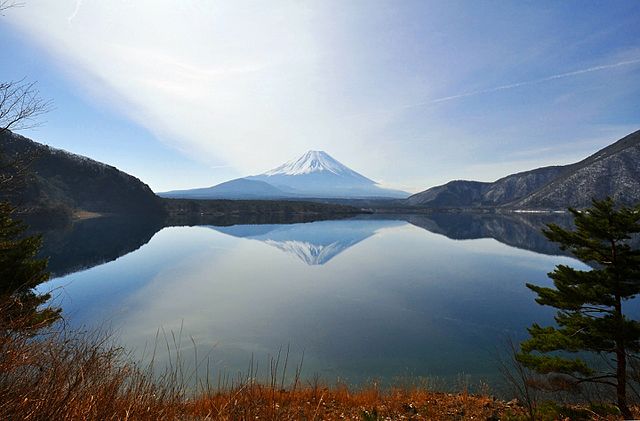Edit 3 October 2019: Updated prices to reflect the increase in Japan's national sales tax.
Mount Fuji (富士山, Fuji-san, lit. 'wealthy warrior mountain') is a dormant volcano, and the tallest (at 3,776m / 12,388 ft.) and most sacred mountain in Japan. Apart from the mountain itself, which attracts thousands of hikers during the summer climbing season, most sites of interest are clustered around a set of five lakes which form an arc around the north side of the mountain. These are the Fuji Five Lakes (富士五湖, Fuji Go-ko). Some of them are larger and have more hotels and attractions surrounding them, while others are smaller and have fewer facilities, but make great sites for camping. And when the weather's right, you can see Mt. Fuji from any one of them.
Major Attractions
1) Lake Yamanaka-ko: The largest of the Fuji Five Lakes.

|
|
Shops and cafes across the Waku Pond at Oshino Hakkai. By zengsx [CC BY-SA 3.0], via Wikimedia Commons |
2) Oshino Hakkai: A tourist-oriented historical village centred
around eight small ponds.

|
|
The view behind Churei-to Pagoda, looking at Mt. Fuji. By https://www.flickr.com/photos/reggiepen/ [CC BY 2.0], via Wikimedia Commons |

|
|
The north entrance of Fuji-Q Highland. Taken by the author on Wednesday, 16 November 2016. |

|
|
The east end of Kawaguchi-ko. Taken by the author on Wednesday, 16 November 2016. |

|
|
The west end of Sai-ko. Taken by the author on Friday, 11 May 2018. |

|
|
Thatched-roof houses at Iyashi no Sato. Taken by the author on Friday, 11 May 2018. |

|
|
Looking out across Shoji-ko from the west end. Taken by the author on Friday, 11 May 2018. |

|
|
Looking out across Motosu-ko from the northwest end. Captain76:Nikon D90+TAMRON SP10-24mm [CC BY-SA 3.0], from Wikimedia Commons |

|
|
A field of flowers at the 2018 Fuji Shibazakura Festival. Taken by the author on Friday, 11 May 2018. |

|
|
Shops and restaurants at Fuji-Subaru 5th Station. Taken by the author in May 2010. |
Orientation and Transportation
The centre-most of the five lakes is Lake Kawaguchi. The two main train and bus stations in the region are Kawaguchi-ko Station, just south of Lake Kawaguchi, and Fuji-san Station, just two stops away from Kawaguchi-ko. Many buses depart from these stations, most notably the three Omni-bus lines.
- The Kawaguchi-ko Sightseeing Bus, or "Red Line", departs every 15 minutes, and travels north across the shore of Lake Kawaguchi.
- The Sai-ko Sightseeing Bus, or "Green Line", departs every 30 minutes, and covers the southern shore of Lake Kawaguchi as well as Lake Sai.
- The Narusawa/Shoji-ko/Motosu-ko Sightseeing Bus, or "Blue Line", departs every 2 hours, and heads west to lakes Shoji and Motosu.
Timetables and route maps of these lines are available on Fujikyu's website
(English) (Japanese),
while individual fares are only listed on their Japanese website
(Japanese). A two-day
pass for unlimited use of the Red, Green, and Blue Line buses costs ¥1,500.
Access
The easiest way to access the Fuji Five Lakes area is by bus. Highway buses travel between central Tokyo and Kawaguchi-ko Station, departing from Shinjuku (2 hours, ¥1,850 online / ¥2,000 at station), Tokyo (2 hours, ¥2,000), and Shibuya (2½ hours, ¥2,000) stations. Most highway buses also stop at Fuji-Q Highland and/or Fuji-San Station. The Japan Rail Pass is not valid for any of these buses. As these buses require reservations and are a popular way to visit a popular destination, I would recommend booking your tickets at least a day ahead of time, if possible. Bus tickets may be reserved online and in English, through sites such as Japan Bus Online (English).
There is also a train route connecting Lake Kawaguchi with central Tokyo. From Shinjuku Station, take the JR Chuo (JC) line to Otsuki (limited express: 70 min / ¥2,540 reserved, local: 90-100 minutes / ¥1,520). At Otsuki Station, transfer and take the Fujikyu Line to Kawaguchi-ko (limited express: 45-50 minutes / ¥1,770 reserved, local: 55-65 minutes / ¥1,170). This method is longer, but is fully covered by the JR Tokyo Wide Area pass, and partially covered (Shinjuku - Otsuki) by the Japan Rail Pass and other JR East passes. IC cards (Suica, Pasmo, etc.) are accepted on the Fujikyu Line trains, but not for buses.
If you are coming in from cities to the west (Nagoya, Kyoto, Osaka, etc.), take the Tokaido Shinkansen to Mishima (Kodama and some Hikari trains only), then take an express bus to Kawaguchi-ko (90 minutes, ¥2,300). Seat reservations are required for the bus. If you cannot make it on this bus, or if you want to save a little money with the Japan Rail Pass, there is an alternate method. From Mishima Station, take the JR Tokaido line to Numazu (5 minutes), transfer to the Gotemba line and ride it to Gotemba (35 minutes, ¥590), and take a local bus to Kawaguchi-ko (75 minutes, ¥1,510). The Japan Rail Pass is valid for all trains on this route.
There is a regional airport called Mt. Fuji Shizuoka Airport (IATA code: FSZ), but it is 95km (60 mi.) southwest of the Fuji Five Lakes area. It handles a few domestic (Fukuoka, Sapporo, Okinawa, etc.) and international (Seoul, Taipei, Shanghai, etc.) flights. To get to the Fuji Five Lakes by public transportation, start by taking a bus to Shizuoka Station (50 minutes, ¥1,000). From there, go to Mishima by either the Tokaido Shinkansen (15-25 minutes, ¥1,980 unreserved, JR Pass OK) or local trains (60 minutes, ¥990), and then take the above express bus to Kawaguchi-ko. More information: (English) (Japanese)




